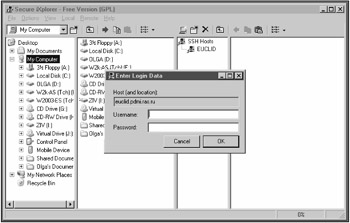Tunneling through Telnet
Despite all of the advantages of Web accelerators, they are not free from serious drawbacks. First, the compression quality is considerably lower than that ensured by the latest versions of compression utilities (this is especially true for RAR). When the server is overloaded, multiple transmission errors occur at the TCP/IP level. Because of this, the user must retransmit the data time and again. This process takes place without the user 's knowledge; however, it increases the downloading time and causes additional expenses. Furthermore, unexpected connection termination is not a rare event for GPRS. Small files are automatically cached by the accelerator server and can be downloaded without losses. However, starting from a certain size , files are transmitted "as is." If the remote server operates without caching, a Web accelerator won't help. And what about email, eMule, and lots of other applications?
True hackers register an UNIX account on the fast channel and connect to it remotely through GPRS using telnet or SSH. Now, data are downloaded from the Internet through the telnet or SSH server instead of directly. The hacker issues a command from a mobile computer, instructing it to download a specific file or even an entire site. The file is downloaded to the hard disk of the intermediate server. If the connection terminates unexpectedly in the course of transmission and it becomes necessary to restart the entire process, no one is going to pay for this. Then the hacker issues the command to pack the file using some compressing utility, such as RAR or Gzip, and send it to a mobile computer through GPRS. If desired, it is even possible to compress all graphics, thus reducing the size of images several times (loss of image quality doesn't matter). Traffic becomes considerably cheaper if you proceed this way.
It should be pointed out, however, that high-quality hosting with telnet or SSH is not free in most cases; it usually costs about $20 per year. However, these expenses are worth it! By choosing this approach, you'll be spared spending ten times more. If you have a DSL connection, it is possible to install the SSH server on your home computer. Go to http://www.openssh.com and choose SSH according to your preferences. I prefer SSHWindows, which takes slightly more than 2 MB and runs on all Windows platforms. In addition, you'll need an SSH/SFTP client, which needs to be installed on the mobile computer with GPRS. Fans of the command line needn't worry, because everything that they might need is supplied as part of SSHWindows. Those who prefer GUI tools might need to spend some time choosing an appropriate client with a graphical interface. In my opinion, the best graphical client is Secure iXplorer (Fig. 30.5), which appears much like Total Commander (originally, Windows Commander). Users of FAR Manager will like the WinSCP plug-in, containing a built-in SFTP client, the new version of which was released several months ago.

Figure 30.5: Secure iXplorer at work
Controlling a desktop computer through GPRS is really cool! In addition, it allows considerable economy. For example, it is possible to use an SSH client to connect to your desktop computer, start an email client (The Bat, for example), delete all spam messages, and transmit only important content over the GPRS channel. If a message contains several archived attachments, then it is possible to unpack them at the desktop computer and transmit only the archive content over GPRS. After this, it is possible to decide which files are needed.
EAN: 2147483647
Pages: 164